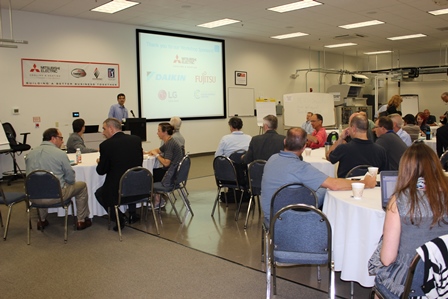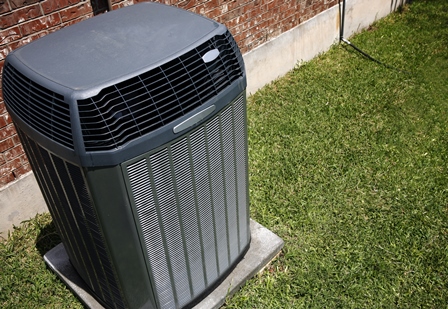
By David Lis | Sun, July 21, 19
Last month in Woburn, Massachusetts, 135 air source heat pump (ASHP) stakeholders gathered to discuss market transformation strategies for ASHPs. NEEP has been hosting this annual in-person workshop since 2014 and this represented our largest event yet. The workshop is a critical opportunity for regional stakeholders to focus on collaborating towards market transformation. Not unlike past years, the event also offers a unique opportunity for our community to make new connections that enable countless collaborations that lead to important progress for ASHPs. Here are just a few of the highlights, takeaways, and thoughts about next steps to ensure we maintain the exciting momentum generated over two days.
Regional strategies continue to provide useful framework
The seven core strategy areas identified in the 2016 Northeast ASHP Market Strategies Report continue to provide a helpful framework for collaborative market transformation activities in 2019. Not only was the program intentionally built to advance several of the strategy areas, but new opportunities identified during the workshop often fell under one of these areas.
- Increase consumer education and awareness
- Increase installer/builder awareness of, and confidence in, ASHPs through expanded training and education
- Reduce upfront costs of intalled systems through robust and aligned promotional programs and the support of alternative business models
- Mobilize state and local policymakers to expand support for ASHPs
- Promote advanced control technologies to allow automated coordination among multiple heating systems
- Enable the promotion of climate-appropriate ASHPs through improved performance metrics
- Develop more accurate tools to predict energy, cost, and GHG savings associated with ASHP installation through collection and analysis of real world performance data
Regional market trending in the right direction
A brief market assessment on the status and recent changes in the ASHP market showed that, between 2013 and 2016, ASHP sales doubled from 50,000 to 1000,000 in the region (New York and New England). Local, state, and regional market actors can celebrate some measure of success for their efforts. While this represents an impressive 20 percent annual growth rate, the gross size of the market still significantly trails the sales of more traditional HVAC systems such as forced air furnaces (235,000 units sold in 2016), hydronic boilers (160,000 units sold in 2016) and central air conditioners (220,000 units sold on 2016). Clearly, there is significant additional opportunity for this technology to continue to evolve and grow.
 Policy winds at our backs
Policy winds at our backs
Public policy objectives throughout the region are increasingly looking to heat pumps as an important solution, specifically to address the urgency of climate change. Exciting announcements in states such as Maine and New York have set aggressive targets for increased heat pump adoption. Maine Governor Janet Mills recently signed new legislation promoting energy efficient heat pumps across the state, to the tune of 100,000 new units by 2025. Similarly, New York’s New Efficiency Initiative is seeking to install approximately 83,000 in the coming years. While policy mechanisms like these were not a focus of any particular session at the workshop, several attendees suggested we bring this forward in future gatherings. NEEP is collaborating with regional stakeholders to clarify model policies that we can help make available across the region.
Getting smarter with marketing
Actors across the market are getting smarter in how they market ASHPs to consumers. We saw this through a variety of examples, including Mitsubishi customizing its marketing and messaging for different target audiences, N.E.T.R. (an ASHP installation company in Massachusetts) investing strategically in its website, and New York City utilizing customer and building data to bring focus to campaigns.
Several questions were raised about the challenge and opportunity associated with communicating the benefits of heat pumps to consumers. The virtues of heat pumps and electrification can get lost on average consumers so can stakeholders come together across state lines to develop a consistent messaging campaign to promote heat pumps? Stakeholders generally support the concept, but struggle to envision a pathway to fund such an endeavor. NEEP is committed to exploring how to overcome these funding challenges to facilitate a broader marketing campaign for heat pumps.
Developing the right measuring stick
NEEP has been very active in the performance metrics space since the launch of the cold-climate ASHP specification and associated product list in 2015. The specification and product list were in response to the need for greater differentiation in product selection for cold-climate applications. While the specification and list have gained traction in the market, there is a realization that we can do even better.
Bruce Harley, of Bruce Harley Energy Consulting, spoke about the multi-year development of the newly published CSA EXP07 test procedure for ASHPs. The test procedure differs fundamentally from the existing procedure in that it is “load-based”, which forces the heat pumps to respond to an imposed load rather than get artificially pinned to a fixed operation. While there is excitement in the completion of the voluntary test procedure, Bruce described a series of testing that has been going on since 2018 to explore the strengths and weaknesses of the procedure. Early results suggest there are some interesting behaviors that come to light through testing in this way. Is the procedure worth the trouble in time and costs? More testing is necessary to fully answer, but stakeholders are anxious to move to an improved test procedure and metrics for ASHPs, particularly in colder climate applications. NEEP will be closely monitoring these activities to see if incorporating the test procedure into the ccASHP Specification might make sense in the future. At the end of the day, it’s crucial that we get the measuring stick right so that we, as a community, can promote the very highest ASHP performers. We’re getting closer, but there are opportunities to do better.
 The future of quality installation
The future of quality installation
While good old fashioned contractor training remains the most effective method of ensuring high performance ASHPs operate to their full potential, new tools and functionalities are coming to market that hold promise in ensuring heat pump systems are installed correctly. Chris Morley from Ecoer described new monitoring technology that can be integrated with its heat pump system that not only assists installers during install and commissioning, but also can provide real-time monitoring of the system to continuously check to see that the heat pump is operating within its optimal parameters and delivering highest value to its customer. This kind of capability could be a game-changer for the industry, as it could help solve several challenges we face today.
Another issue that came up around ensuring quality installations and customer satisfaction is this idea of a nexus between ASHPs and home performance. Courtney Moriarta from NYSERDA spoke about a new heat pump-ready program that is under development that is trying to leverage the strong home performance market in New York to deliver “hot leads” to ASHP dealers. It’s not only a business development pipeline for heat pump dealers, but the program can also be more confident that those customers that have weatherized their homes will be far more likely to have a positive experience with a new heat pump system. Finding the right balance between heat pump promotion and required home performance is difficult to strike. Further conversations across regional stakeholders will be important going forward.
New construction….It’s electric
As heating and cooling loads drop dramatically with high performance new construction building practices, ASHPs are increasingly being seen by architects, engineers, and builders as a preferred technology to heat and cool homes. Tim Gould, of Ace Energy Services, spoke about some of the configurations that his team has been specifying in a number of new home designs. The crowd got very excited to hear Tim speak about a couple of large multi-family developments not only going all heat pumps, but going all electric. The developments found benefits in avoiding the costs and risks associated with gas. Attendees clearly want more resources to help support the growth of heat pumps in new construction and all-electric homes and developments.
VRF wrinkle
One new wrinkle to this year’s workshop was the inclusion of VRF technology, a more commercially-relevant ASHP technology. NEEP provided a high level view of its forthcoming VRF market strategy report. While there are a number of strategies unique to VRF versus residentially-size ASHPs, there are many strategies closely aligned between the two. NEEP looks forward to finalizing the report and working with stakeholders to make a deeper impact on market growth in this sector as well.
Hurry up, slowly
With so many exciting examples of how this market is moving forward and how leaders are implementing cutting edge practices, there is a growing confidence that the market can respond to the lofty targets policies and programs are asking of heat pumps. One theme that emerged from the workshop was a need to find balance between pace and quality. It is incumbent on our region to be sure that as we promote ASHPs we also ensure that the technology is being applied in the right way, sized in the right way, installed in the right way, and operated and maintained in the right way. Overlaying ambitious targets with responsible quality assurances will ensure the market grows sustainably for years to come.
The party isn’t over
While we did have to say our goodbyes back in June, the party is definitely not over. NEEP’s ASHP Initiative provides a regional framework for ASHP stakeholders to work in a number of important strategy areas towards market transformation. The initiative is structured heavily around stakeholder engagement and working towards solutions in collaborative ways.
If you don’t want to wait until next year to keep working towards solutions, consider joining NEEP’s ASHP Initiative. Otherwise, see you at next year’s workshop.
